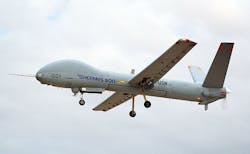NASA reaches out to industry to determine state of the art in UAV sense and avoid avionics
EDWARDS AIR FORCE BASE, Calif., 13 June 2016. U.S. aviation authorities are reaching out to industry for help in formulating avionics performance standards for medium-sized unmanned aerial vehicles (UAV) that must be able to sense and avoid other aircraft in controlled airspace.
Officials of the National Aeronautics and Space Administration (NASA) issued a sources-sought notice Friday (NND16828627L) for the Alternative Airborne Surveillance Systems for Beyond Visual Line of Sight Unmanned Aircraft Systems (UAS) Detect and Avoid project.
This survey -- part of the NASA UAS Integration in the National Airspace System (UAS-NAS) project -- seeks to determine industry's ability to design and integrate airborne sensors of relatively small size, weight, and power consumption (SWaP) for medium-size UAVs.
Of primary concern are unmanned aircraft operating under instrument flight rules (IFR) at altitudes higher than 500 feet at beyond-line-of-sight distances from their control centers.
These unmanned aircraft are not able to carry large surveillance sensors, yet still need to watch their surroundings for other aircraft. Candidate sensors include electro-optical/infrared (EO/IR), light detection and ranging (LIDAR), relatively small radar systems, or small Automatic Dependent Surveillance-Broadcast (ADS-B) avionics.
NASA experts will use industry responses to help formulate RTCA Special Committee-228 Minimum Operational Performance Standards (MOPS) for medium-sized UAVs. The request for information was released on behalf of the NASA Armstrong Flight Research Center at Edwards Air Force Base, Calif.
Of particular interest to NASA are UAVs expected to operate side-by-side with manned commercial and general-aviation aircraft flying in FAA Class D, E, or G airspace.
FAA Class D describes controlled airspace that extends from the surface to 2,500 feet surrounding airports with operational control towers. In this airspace each aircraft must establish two-way radio communications with tower.
Related: Navy chooses RDRTec to develop common sense-and-avoid radar for Fire Scout and Triton UAVs
Class E describes airspace between 14,500 and 18,000 feet over the U.S. and over the ocean within 12 nautical miles of the coast. It also describes U.S. airspace above 60,000 feet. Class G, meanwhile, is uncontrolled airspace. NASA experts also would like to hear from manufacturers of optionally piloted aircraft expected to operate in these kinds of conditions.
Makers of relevant airborne sensors or aircraft should respond to NASA no later than 27 June 2016 by email at [email protected], or by post at NASA-Armstrong Flight Research Center, P.O. Box 273 M/S S323, Edwards, CA 93523.
For questions or concerns contact NASA's Rosalia Toberman by email at [email protected], or by phone at 661-276-3931.
More information is online at https://www.fbo.gov/spg/NASA/DFRC/OPDC20220/NND16828627L/listing.html.

